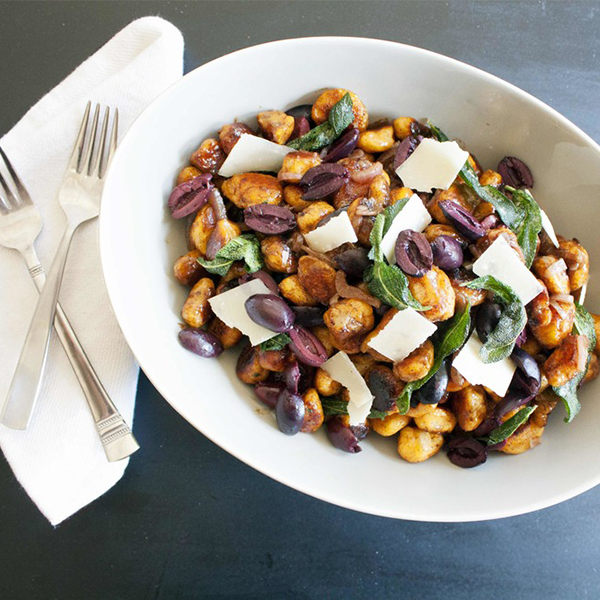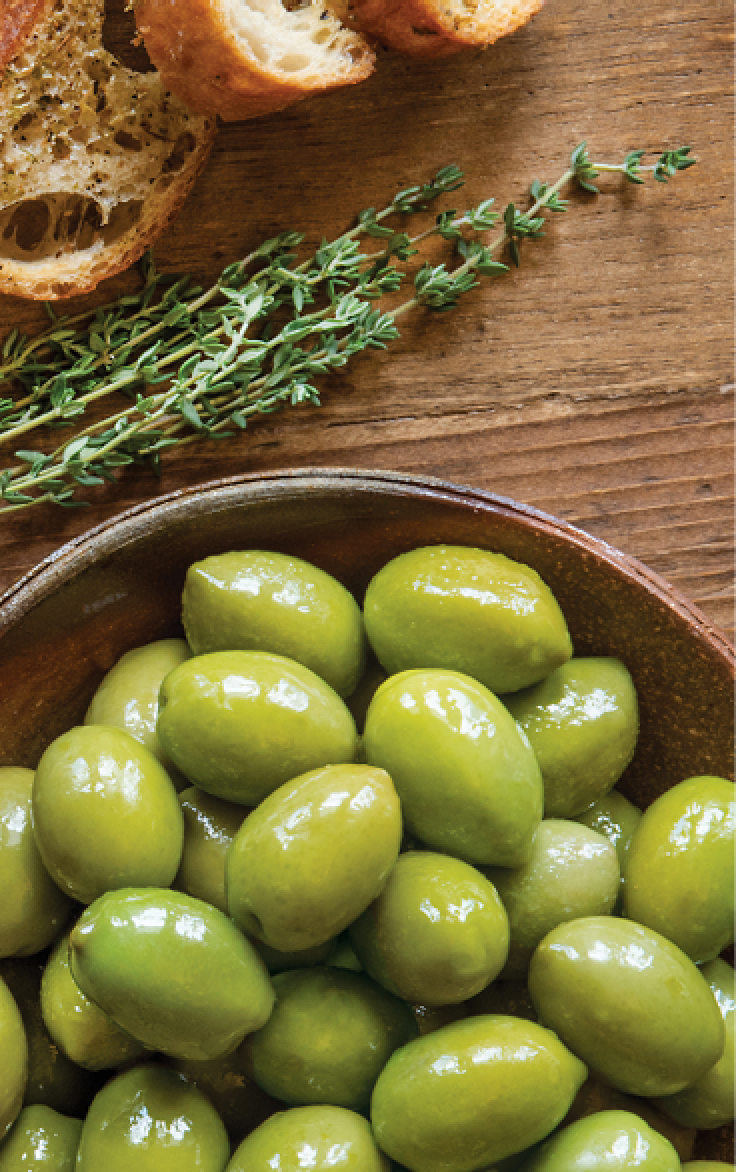
Gnocchi, pronounced “Nee-o-kee” by the way- and certainly not pronounced “No-Kee”, is a strange beast in the world of Italian cooking. A gnoccho, (the fun-to-say name of an individual piece of gnocchi) is really more dumpling than pasta, yet the soft, pillow-y potato nuggets have been finding their way into the pasta sections of an ever-increasing amount of restaurant menus. This would be fine if it didn’t mean that much of the time gnocchi was typecast as pasta, served in a thick tomato or heavy cream sauce. The classic preparation of gnocchi is much lighter and simpler; just a light coating of butter, a few sage leaves and perhaps a sprinkle of Parmigiano Reggiano.
This recipe is an autumnal take on that concept, with the gnocchi made with sweet potato and the butter browned to give it an added nuttiness. Fried sage leaves are a favorite garnish of mine, and a really nice textural element in almost any dish. Crisped in the brown butter here they add flavor to the sauce and a bit of crunch to contrast the cushion-y gnocchi. The balsamic vinegar, for its part, adds just enough acidity to give the dish a bit of an edge and keep it from slipping into creamy-richness overload.
Whether or not gnocchi really qualifies as pasta in the purest sense isn’t terribly important, after all it is indisputably a comfort food and it excels at comforting. You don’t need to have a grandmother who made it, you don’t even need to be Italian, a taste of these rich, pillow-y dumplings is the culinary equivalent of a warm blanket and a crackling fire on a cold night.

Ingredients
- 1 1/2 pounds sweet potatoes (yams) halved lengthwise
- 1/2 pound Russet potatoes halved lengthwise
- 1 tbsp Divina Renieris Estates Extra Virgin Olive Oil
- 2 tsp Kosher salt plus more to taste
- Freshly ground black pepper
- 1/4 cup finely grated Parmigiano-Reggiano cheese
- 1 large egg lightly beaten
- 3 tbsp honey
- 1 1/2 to 2 1/2 cups all purpose flour
- 4 tbsp unsalted butter
- 12 to 15 fresh sage leaves
- 2 medium shallots quartered and thinly sliced
- 3 tbsp balsamic vinegar
Directions
For the gnocchi:
- Heat oven to 425° and arrange a rack in the middle.
- Drizzle the potatoes with olive oil, season with salt and pepper
- Place potatoes on a rimmed baking sheet, cut-side down, and roast until fork tender, about 30 minutes.
- Set aside until cool enough to handle.
- Once cool, scoop flesh out of skins then mash flesh with a potato ricer or the back of a fork
- Stir in cheese, egg, honey, and salt into the mashed potatoes.
- Mix in flour, about ½ cup at a time, until soft dough forms. Add additional salt to taste. Dough should be damp but not sticky.
- Turn dough out onto floured surface and shape into a square. (If like us, you’re operating with limited counter-top or if the dough is too sticky to roll out, it’s also possible to skip these next couple steps completely. Simply place the dough into a pastry bag and squeeze it out, cutting every ½ inch.)
- Divide into 16 equal pieces. Rolling between palms and floured work surface, form each piece into a ½ inch-diameter rope, sprinkling with flour as needed if too sticky. Don’t add too much additional flour, as too much will make for heavy gnocchi.
- Cut each rope into ½ -inch pieces. Afterwards you may want to roll each piece over the tines of a fork to indent
- Bring a large pot of heavily salted water to a slow boil over medium-high heat.
- Working in batches, simmer gnocchi until tender, about 5 minutes. (If you prefer a crispier gnocchi, you can parboil them and then transfer to a pan to sautée in butter until golden brown.)
- Transfer gnocchi to a rimmed baking sheet.
- Reserve 2/3 cup of pasta cooking water and drain the rest.
For the sauce:
- In a large frying pan, melt butter over medium heat. Once it foams, add sage and cook until crisp and fragrant.
- Remove sage to a plate and return frying pan to stove.
- Add shallot and allow the butter to brown and become fragrant with a hazelnut-like smell. Scrape along the bottom to prevent it from sticking and burning.
- When the butter browns, immediately remove from heat, and carefully stir in the vinegar, make sure to keep your face away from the pan as the fumes can burn your eyes or nose.
- Stir in pasta and ½ cup of the reserved pasta water, return to heat, and cook until the sauce just begins to stick to the pasta.
- Finish with additional pasta water, salt and black pepper to taste, the crisp sage or sliced kalamatas, and freshly shaved Parmigiano-Reggiano.


